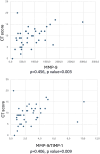MMP-9 metalloproteinase and its regulator are not associated with mid-term CT residual abnormalities in patients with COVID-19 pneumonia
- PMID: 40291835
- PMCID: PMC12033756
- DOI: 10.1177/20584601251330563
MMP-9 metalloproteinase and its regulator are not associated with mid-term CT residual abnormalities in patients with COVID-19 pneumonia
Abstract
Background: COVID-19 patients may have residual pulmonary alterations after the acute disease, with fibrotic-like alterations. Since metalloproteinases (MMP) and their regulators may be involved in inflammation and abnormal repair processing, we aimed to investigate the correlations between MMP-9, a tissue inhibitor of metalloproteinases (TIMP-1) and chest CT abnormalities in acute phase and mid-term follow-up.
Methods: COVID-19 patients with plasma analyses and CT scans performed at acute onset and 3 months after discharge (T post) were evaluated. MMP-9, TIMP-1, and MMP-9/TIMP-1 ratio were analyzed. CT extents of COVID-19 pneumonia and fibrotic-like alterations were visually scored (score range 0-25). Spearman rank correlation analysis (p-value <.05) was computed between acute and mid-term plasma analyses and CT scores.
Results: 39 patients were enrolled. At hospital admission, MMP-9, TIMP-1, and MMP-9/TIMP-1 had a median of 240.5 ng/mL, 258.8 ng/mL, and 0.9. The median CT global and fibrotic-like scores were 9 and 6. At T post, MMP-9 and TIMP-1 were not statistically different (p-value <.05). There was a reduction of CT global score (p-value = .00007). A significant correlation was found between MMP-9 and CT global score at hospital admission (ρ = 0.456, p-value = .003) and between MMP-9/TIMP-1 ratio and CT global score at hospital admission (ρ = 0.406, p-value = .009). No other significant correlations were found between plasma enzymes and CT alterations, both in acute and mid-term follow-up.
Conclusion: MMP-9 plasma levels and MMP-9/TIMP-1 ratio correlate with lung involvement during the acute phase. None of the levels of MMP-9, TIMP-1, and MMP-9/TIMP-1 ratio may be adopted as predictors of residual pulmonary alterations in mid-term follow-up.
Keywords: COVID-19; ELISA; MMP-9; TIMP-1; computed tomography; matrix metalloproteinases.
© The Author(s) 2025.
Conflict of interest statement
The author(s) declared no potential conflicts of interest with respect to the research, authorship, and/or publication of this article.
Figures


Similar articles
-
Tissue Inhibitor of Matrix Metalloproteinases-1 (TIMP-1) and Pulmonary Involvement in COVID-19 Pneumonia.Biomolecules. 2023 Jun 26;13(7):1040. doi: 10.3390/biom13071040. Biomolecules. 2023. PMID: 37509076 Free PMC article.
-
An evaluation of matrix metalloproteinase-9 (Mmp-9) and tissue inhibitor metalloproteinase-1 (Timp-1) Serum levels and the Mmp-9/Timp-1 Ratio in Covid-19 patients.Afr Health Sci. 2023 Mar;23(1):37-43. doi: 10.4314/ahs.v23i1.5. Afr Health Sci. 2023. PMID: 37545954 Free PMC article.
-
[Analysis of correlation between pulmonary function and expression levels of matrix metalloproteinases-9 and tissue inhibitor of metalloproteinase-1 among toluene diisocyanate exposed workers].Zhonghua Yu Fang Yi Xue Za Zhi. 2016 May;50(5):418-22. doi: 10.3760/cma.j.issn.0253-9624.2016.05.006. Zhonghua Yu Fang Yi Xue Za Zhi. 2016. PMID: 27141897 Chinese.
-
Matrix metalloproteinases and tissue inhibitors of metalloproteinases in sera and tissue of patients with Dupuytren's disease.Plast Reconstr Surg. 2003 Oct;112(5):1279-86. doi: 10.1097/01.PRS.0000081462.40448.49. Plast Reconstr Surg. 2003. PMID: 14504511
-
Association of Plasma Matrix Metalloproteinase and Tissue Inhibitors of Matrix Metalloproteinase Levels With Adverse Treatment Outcomes Among Patients With Pulmonary Tuberculosis.JAMA Netw Open. 2020 Dec 1;3(12):e2027754. doi: 10.1001/jamanetworkopen.2020.27754. JAMA Netw Open. 2020. PMID: 33258908 Free PMC article.
Cited by
-
An Italian Study of PM0.5 Toxicity: In Vitro Investigation of Cytotoxicity, Oxidative Stress, Intercellular Communication, and Extracellular Matrix Metalloproteases.Int J Mol Sci. 2025 Jul 15;26(14):6769. doi: 10.3390/ijms26146769. Int J Mol Sci. 2025. PMID: 40725016 Free PMC article.
References
-
- Gulick RM, Pau AK, Daar E, et al. National institutes of health COVID-19 treatment guidelines panel: perspectives and lessons learned. Ann Intern Med 2024; 177: 1547–1557. - PubMed
-
- Emanuel EJ, Persad G, Upshur R, et al. Fair allocation of scarce medical resources in the time of covid-19. N Engl J Med 2020; 382: 2049–2055. - PubMed
LinkOut - more resources
Full Text Sources
Research Materials
Miscellaneous

